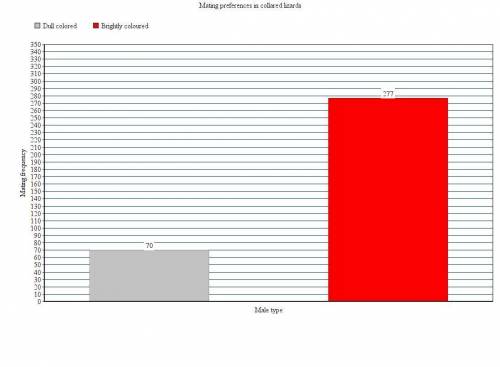
Biology, 21.06.2019 20:30 kendricklamar29
The collared lizard is a species found in the desert southwest. male collared lizards show considerable color variation, ranging from brightly colored to a very dull pattern. your goal is to determine the function, if any, of male color patterns in collared lizards, using the scientific method. your tentative explanation is that male color plays a role in attracting females for mating purposes. you predict that females will preferentially choose brightly colored males over dull-colored ones. to test this prediction, you observed the interactions of female collared lizards with their male counterparts. you selected males that were the same age and size, and that differed only in their coloration pattern. you placed equal numbers of the two types of male lizards, bright and dull, in aquariums, along with one female lizard per aquarium. out of 350 aquariums observed, the female chose to mate with the brightly colored male 277 times, and the dull-colored male 70 times. in 3 instances, the females did not mate with either type. create a bar graph of your data, plotting the type of male (dull or brightly colored) on the x-axis. on the y-axis, plot the frequency with which each type of male was chosen by females. using this graph, answer the following question(s). is it reasonable to conclude (i. e., is it supported by the data) that female collared lizards prefer more brightly colored male lizards over dull-colored males?

Answers: 3


Another question on Biology

Biology, 21.06.2019 17:00
In tossing one coin 10 times, what are your chances for tossing a head? a tail? 2. in tossing one coin 100 times, what are your chances for tossing a head? a tail? 3. in tossing one coin 200 times, what are your chances for tossing a head? a tail? deviation = ((absolute value of the difference between expected heads and observed heads) + (absolute value of the difference between expected tails and observed tails)) divided by total number of tosses. this value should always be positive. 4. what is the deviation for 10 tosses? 5. what is the deviation for the 100 tosses? 6. what is the deviation for 200 tosses? 7. how does increasing the total number of coin tosses from 10 to 100 affect the deviation? 8. how does increasing the total number of tosses from 100 to 200 affect the deviation? 9. what two important probability principles were established in this exercise? 10. the percent of occurrence is the obtained results divided by the total tosses and multiplied by 100%. toss the coins 100 times and record your results. calculate the percent occurrence for each combination. percent head-head occurrence: percent tail-tail occurrence: percent head-tail occurrence:
Answers: 1


Biology, 22.06.2019 21:00
Me asap i need during photosynthesis, the following reaction takes place: carbon dioxide + water + light energy → sugar + oxygen during cellular respiration, the following reaction takes place: sugar + oxygen → carbon dioxide + water + chemical energy given this information, how are photosynthesis and cellular respiration related? question 2 options: a the products of photosynthesis are the reactants of cellular respiration. b photosynthesis and cellular respiration both start with the same materials. c photosynthesis and cellular respiration both produce the same materials. d the same type of energy is found in both photosynthesis and cellular respiration.
Answers: 1

Biology, 22.06.2019 23:00
Which would stop hardy-weinberg equilibrium from happening?
Answers: 1
You know the right answer?
The collared lizard is a species found in the desert southwest. male collared lizards show considera...
Questions


Mathematics, 05.10.2020 14:01





History, 05.10.2020 14:01

Social Studies, 05.10.2020 14:01

Geography, 05.10.2020 14:01

Physics, 05.10.2020 14:01





Arts, 05.10.2020 14:01

Biology, 05.10.2020 14:01


Mathematics, 05.10.2020 14:01


Business, 05.10.2020 14:01




